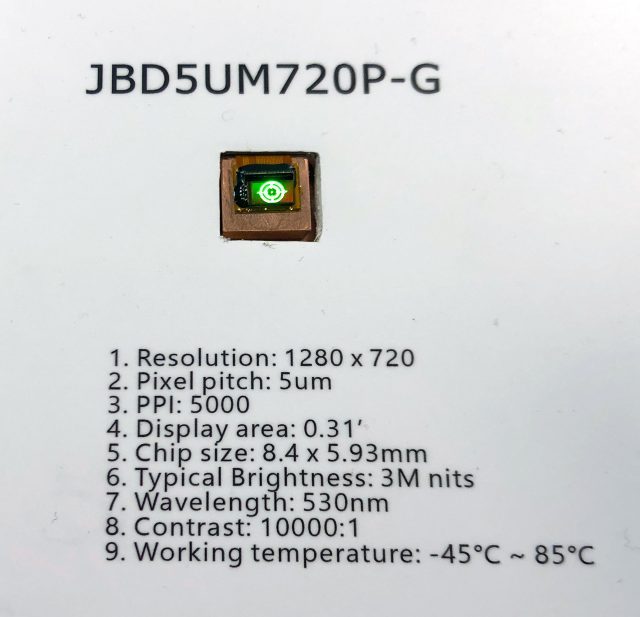This week at CES 2020, China-based Jade Bird Display (JBD) revealed its latest portfolio of micro LED displays which the company is positioning as an ideal fit for AR and VR devices. Among the company’s miniscule displays is a one that’s smaller than a penny but capable of a blinding 3,000,000 nits.
Founded in 2015, JBD has been working to commercialize micro LED display technology. The company says its focus is on creating the “smallest, brightest, and most efficient micro-display panels,” and is “currently transitioning from a research-and-development phase into a manufacturing-and-sales phase.”
At CES 2020 this week, the company demonstrated its brightest and most pixel-dense displays to date. The displays, while still just monochromatic, could disrupt the design of AR and VR headsets thanks to their extreme brightness.
Blinded By the Light


On the bright end of the spectrum is the JBD5UM720P-G, a 1,280 × 720 micro LED display capable of an absolutely absurd 3,000,000 nits of brightness. It’s hard to even put that number into a meaningful context, but I’ll try.
A typical computer monitor is around 300 nits. The iPhone 11 display is rated at 625 nits. An HDR TV can push 2,000 nits.
3,000,000 would literally be painful (and even dangerous) to look at… so who the hell needs that much brightness? Well, it turns out that having an extremely bright display source means greatly reducing a significant optical design constraint: transparency.
Optics generally need to be highly transparent, especially when using novel compact designs (like the kind you’d want in a small form-factor headset) which compress the optical path by bouncing light back and forth many times. Every bounce and pass through a lens losses light based on the material’s transparency of reflectivity, dimming the image as the light progresses along the optical path. Especially for those AR headsets which are intended to be used in full outdoor daytime brightness, display brightness is a serious challenge.
With 3 million nits of brightness at the source, the optical path doesn’t need to worry nearly as much about light efficiency, potentially allowing the use of cheaper lenses and more complex optical designs which can instead optimize for other factors. With 3 million nits brightness, the optical path of an AR or VR headset could be just 0.01% efficient and you’d still get a whopping 3,000 nits out the other side.
And if you don’t need that absolutely absurd amount of brightness (because your optics have even, say, 10% efficiency), you’ll can still benefit by running the display at a much lower brightness and saving on power.
A Penny For 2,560 × 1,440 Thoughts
On the extreme pixel density side of things, the JDB25UMFHD-B packs an incredible 2,560 × 1,440 pixels into a display smaller than a penny—just 0.31′ diagonally. At 10,000 pixels per inch, the distance between pixels is 2.5 micrometers. Just to remind you, micrometers are one order of magnitude larger than nanometers (there’s 1,000 nanometers in a micrometer) and one order of magnitude smaller than millimeters (1,000 micrometers in a millimeter).
And if you need brightness from this display, fear not, the JBD25UMFHD-B is still capable of a blinding 150,000 nits.
Though it’s monochromatic, this display is high performance; JBD says it’s got a blistering 360Hz refresh rate and 10,000:1 contrast ratio.
Limitations & Applications
Today, JBD’s micro LED displays are monochromatic and only offer 256 color levels which significantly limits their use-cases for the time being—you won’t be watching video playback, browsing the web, or playing full FOV games on displays like these any time soon.
However, they could be absolutely ideal for AR glasses which aim to communicate raw information through text, symbols, and other spatial elements. Use-cases like displaying a line and a bright arrow floating down the road to show the next turn on your GPS route, projecting a control interface onto your palm, or floating your latest text message in front of you could all be extremely compelling if done correctly in a headset equipped with these displays.
Coupled with great headtracking, the 360Hz refresh rate of the JBD25UMFHD-B (and brightness capable of matching any brightness levels seen in the real world) could go a long way toward making AR elements to look absolutely locked to the real world around you.
JBD says it’s working on bichromatic and trichromatic versions of its micro LED displays, which would successively unlock a broader range of use-cases, including the potential to be used in compact VR headsets, like the concept VR glasses Oculus showed back in 2018.

